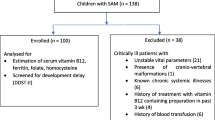Summary
There have been many studies on the nutrition and the growth status of children from rural and remote western regions of China, whereas researches on children from urban low-income families are scarce. This study aimed to investigate the growth and nutritional status of children under five years of age from urban low-income families in China. There were 169 children aged 25–60 months recruited from Xiangtan and Jilin, two cities with a population of 2.81 million and 4.26 million respectively, in China in this cluster cross-sectional study. Data were collected on demographic and socioeconomic characteristics, the feeding practices and the incidence of anemia and diarrhea. The results showed that the prevalence of low birth weight and macrosomia was 7.1% and 9.5% for the two cities, respectively, which was higher than that for other cities in China (1.5% and 5.9%). Of all the sampled children, 14.6% and 8.2% suffered anemia and diarrhea, respectively. Multivariate analysis showed that legumes or nuts fed in a 24-h recall increased the risk of anemia (OR=4.9). Children whose caregivers began to introduce complementary foods relatively late would have high diarrhea prevalence (OR=1.4). In conclusion, the prevalence of anemia and diarrhea in under-five children from urban low-income families in China is relatively high. The growth and nutritional status of these children is greatly affected by feeding practices. A series of measures should be taken by relevant government departments to improve the health of these children.
Similar content being viewed by others
References
Liu L, Oza S, Hogan D, et al. Global, regional, and national causes of child mortality in 2000-13, with projections to inform post-2015 priorities: an updated systematic analysis. Lancet, 2015,385(9966): 430–440
Skogen JC, Overland S. The fetal origins of adult disease: a narrative review of the epidemiological literature. JRSM Short Rep, 2012,3(8):59
Agostoni C, Fattore G. Growth outcome: nutritionist perspective. World Rev Nutr Diet, 2013,106: 12–18
Christian P, Mullany LC, Hurley KM, et al. Nutrition and maternal, neonatal, and child health. Semin Perinatol, 2015,39(5): 361–372
Walker SP, Wachs TD, Grantham-McGregor S, et al. Inequality in early childhood risk and protective factors for early child development. Lancet, 2011,378(9799): 1325–1338
Sobti J, Mathur GP, Gupta A, et al. WHO’s proposed global strategy for infant and young child feeding: a viewpoint. J Indian Med Assoc, 2002,100(8): 502–504,506
Chen CM, Lv SH. Copenhagen consensus. Chin J Health Edu (Chinese), 2012,28(6):492
Wang YP, Miao L, Dai L, et al. Mortality rate for children under 5 years of age in China from 1996 to 2006. Public Health, 2011,125(5): 301–307
Zong XN, Li H. Physical growth of children and adolescents in China over the past 35 years. Bull World Health Organ, 2014,92(8): 555–564
McLean E, Cogswell M, Egli I, et al. Worldwide prevalence of anaemia, WHO Vitamin and Mineral Nutrition Information System, 1993-2005. Public Health Nutr, 2009,12(4): 444–454
Balarajan Y, Ramakrishnan U, Ozaltin E, et al. Anaemia in low-income and middle-income countries. Lancet, 2011, 378(9809): 2123–2135
Black RE, Victora CG, Walker SP, et al. Maternal and child undernutrition and overweight in low-income and middleincome countries. Lancet, 2013,382(9890): 427–451
Lin LM, Song XF, Liu YL, et al. Relationship between vitamin A deficiency and anemia for Chinese children. Chin J Child Health Care (Chinese), 2003,11(4): 242–244
Tolentino K, Friedman JF. An update on anemia in less developed countries. Am J Trop Med Hyg, 2007,77(1): 44–51
Black RE, Allen LH, Bhutta ZA, et al. Maternal and child undernutrition: global and regional exposures and health consequences. Lancet, 2008,371(9608): 243–260
Hipgrave DB, Fu X, Zhou H, et al. Poor complementary feeding practices and high anaemia prevalence among infants and young children in rural central and western China. Eur J Clin Nutr, 2014,68(8): 916–924
Luo R, Shi Y, Zhou H, et al. Anemia and feeding practices among infants in rural Shaanxi Province in China. Nutrients, 2014,6(12): 5975–5991
Villar J, Cheikh Ismail L, Victora CG, et al. International standards for newborn weight, length, and head circumference by gestational age and sex: the Newborn Cross-Sectional Study of the INTERGROWTH-21st Project. Lancet, 2014,384(9946): 857–868
Wang J, Zhao LY, Piao JH, et al. Nutrition and development status of neonate in 16 counties in 8 provinces in China. Proceeding of the Seventh National Conference of Chinese Nutrition Society of Maternal and Child Nutrition, 2010,82–85
Zhang J, Jiang J, Himes JH, et al. Determinants of high weight gain and high BMI status in the first three months in urban Chinese infants. Am J Hum Bio, 2012,24(5): 633–639
Chen FF, Wang WP, Teng HH, et al. Trends and determinants of birthweight among live births in Beijing, 1996-2010. Chin J Evid Based Pediatr, 2012,7(6): 418–423
Li LM, Rao KQ, Kong LZ, et al. A description on the Chinese national nutrition and health survey in 2002. Zhonghua Liu Xing Bing Xue Za Zhi (Chinese), 2005, 26(7): 478–484
Ruel MT. Operationalizing dietary diversity: a review of measurement issues and research priorities. J Nutr, 2003,133(11 suppl 2):3911S–3926S
Hurrell R. How to ensure adequate iron absorption from iron-fortified food. Nutr Rev, 2002,60(7 Pt 2):S7–S15
Motarjemi Y, Käferstein F, Moy G, et al. Contaminated weaning food: a major risk factor for diarrhoea and associated malnutrition. Bull World Health Organ, 1993,71(1): 79–92
Noughani F, Bagheri M, Ramim T. Nutritional habits of mothers and children in the age group 0-4 years in Iran. Ecol Food Nutr, 2014,53(4): 410–418
Author information
Authors and Affiliations
Corresponding authors
Additional information
This work was supported by the project “Survey on the Nutritional Status of Children from Urban Low-income Families in China” funded by Center for Monitoring and Verification of Low-income Families of Chinese Ministry of Civil Affairs, the Humanity and Social Science Project of Chinese Ministry of Education (No. 10YJC630215) and the Fundamental Research Funds for the Central Universities (No. HUST 2014 TS055).
Rights and permissions
About this article
Cite this article
Guo, Yf., Gan, Yy., Guo, Cn. et al. Nutritional status of under-five children from urban low-income families in Xiangtan and Jilin in China. J. Huazhong Univ. Sci. Technol. [Med. Sci.] 37, 74–78 (2017). https://doi.org/10.1007/s11596-017-1697-9
Received:
Revised:
Published:
Issue Date:
DOI: https://doi.org/10.1007/s11596-017-1697-9



